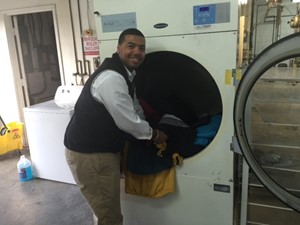A Cleaner World Blog
What is Dry Cleaning?
Believe it or not, dry cleaning dates back to 79 AD Pompeii where clothes cleaners used ammonia, lye, and clay to absorb dirt, sweat, and grease from wool clothing. Fast forward to somewhat more modern times where a maid spilled kerosene on a greasy tablecloth; as the kerosene evaporated, she noticed that much of the grease had been removed. This, of course, led to lots of experimenting, and in 1821, Thomas Jennings, a tailor from the United States, received a patent for a method known as dry scouring, which cleaned clothes that would otherwise be damaged by more traditional cleaning methods.
Today’s dry-cleaning process is streamlined and sophisticated using both solvent and computer-controlled machines.
A Cleaner World’s Dry Cleaning Process
- Garments are placed inside a large machine that looks a lot like an extra-large version of a front load washing machine. The dry-cleaner sets the program based on the load of clothing being cleaned. A Cleaner World uses Sanitone cleaning products along with the dry-cleaning solvent to help remove soils from garments, suspend the soils in the solvent, and help carry the soils away so they aren’t reabsorbed; the solvent is liquid, so your clothes do get wet, but the solvent doesn’t contain water.
- The cycle runs just as it does with a washing machine, but when cleaning and rinsing are complete, the machine doesn’t drain and dispose the liquid. Instead, it is sent to a distillation unit where it is separated, cleaned, recycled, and purified so that it can be used again.
- As the solvent runs through the purification process, a small amount of residue containing solvent, carbon, lint, dyes, grease, and soil is captured by a filter system.
- After all the solvent is drained from the cleaning drum, the drying cycle begins. The temperature is carefully controlled to ensure that any remaining solvent is evaporated and to prevent heat damage to clothing.
- The warm air from the drying process passes through an enclosed cooling chamber so that solvent vapors are condensed and returned to the solvent holding tank. This allows for even more solvent to be recovered and also prevents any solvent from being released into the air.
- Once the load is complete, the machine will turn off and unlock allowing the dry cleaner to remove the clothes, inspect them, and send them off to the finishing department.
Dry cleaning will always be an important part of caring for our garments, and here are just two reasons why:
- Water causes the fibers in fabric to swell, which could lead a garment to shrink or fade in the process.
- Dry cleaning easily removes oil-based stains.
Ultimately the cleaning method used should be the method that’s best for the garment. That’s why A Cleaner World is not only your neighborhood dry cleaner, we also offer professional wet cleaning, and as Mike Smith always says, “We have to be smarter than the care label.” That translates to our managers, dry cleaners, and spotters being trained not only to check the care label but also to determine, based on the garment, the best method of care for each piece.
Questions about dry cleaning? Send them to wildwednesday@acleanerworld.com.



